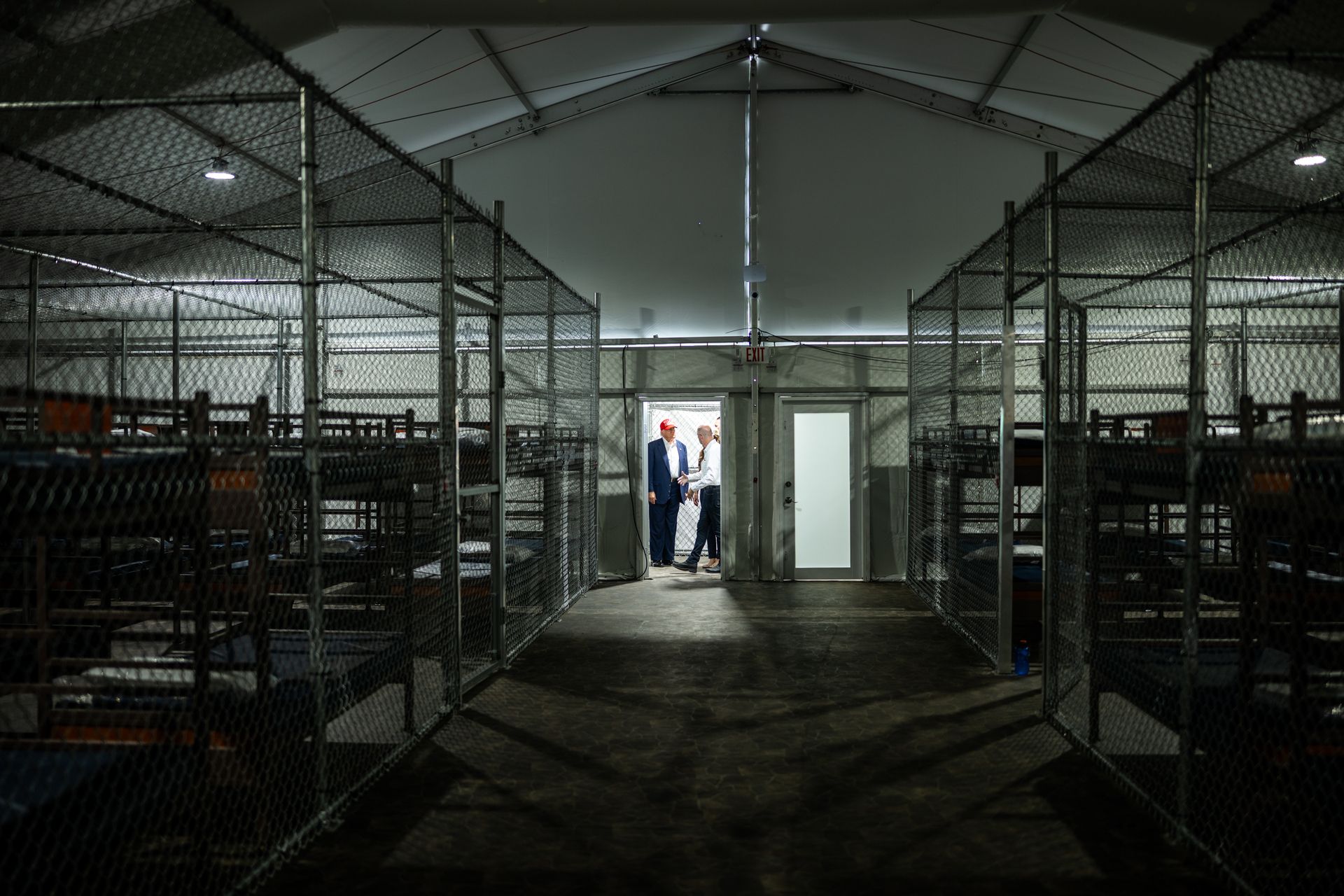
Interior of “Alligator Alcatraz,” with President Donald Trump in the background (Public Domain)
“Alligator Alcatraz,” the public moniker for an abandoned airport in the Florida Everglades that has been turned into an immigration detention center, has captured national attention since its opening on July 3.
While initially embraced by right-leaning politicians and members of the public as a dark sort of anti-immigrant PR stunt, Alligator Alcatraz has since been identified as a threat to immigrant health, the economy, and the environment.
Politicians and journalists visiting the detention center have described it as “appalling,” “inhumane,” and “a national disgrace.” And while officials stated that Alligator Alcatraz was designed to house “deranged psychopaths,” records show that hundreds of immigrants with no criminal record have been detained behind its walls.
While the cruelty of Alligator Alcatraz is disturbing, and increasingly so to those on both sides of the aisle, historical precedent suggests that we shouldn't be surprised by its existence. Underneath the crass and unsettling messaging from the White House, Alligator Alcatraz’s strongest claim to legitimacy is grounded in an unfortunately effective recipe: when resources are scarce, blame immigrants, remove them, and make a cruel spectacle out of it.
Take, for example, when Vice President JD Vance answered a question on rising housing costs in his VP debate with Tim Walz and essentially blamed it all on “25 million illegal aliens” (a number that is more than double the 11.7 million undocumented immigrants living in the United States). This narrative of “resource scarcity” has since been a hallmark of Trump’s White House’s messaging on mass deportations, with everything from a lack of funds for natural disasters that allegedly went to paying immigrants to vote to supposedly billions of dollars in migrant benefit fraud.
Blaming resource scarcity on immigrants did not, of course, start with Trump. During the Bush administration, President Bush warned of “nearly 10 million Americans [who] had their identities stolen by criminals who rob them and the nation's businesses of nearly $50 billion through fraudulent transactions.” He later used the felonious charge of identity theft to justify his massive worksite raid on Agriprocessors Inc. in Postville, Iowa, where ICE arrested 398 workers in a highly visible spectacle of military might.
And during the Great Depression, perhaps the historical period best known for resource scarcity, massive numbers of coerced repatriations included cases like that of Manuel Constante in Detroit, who recounts childhood memories of Mexican people being picked up at random from the streets, as he claims, by order of the state’s Welfare department.
Don’t Get Too Close or You’ll Get Bitten
But while history shows that politicians use resource scarcity to justify anti-immigrant cruelty, that is not the full story. In many of these cases, history also shows that administrations can overplay their hand, cranking up the macabre imagery and metaphor until the public can no longer tolerate it.
After the Postville Raid, comparisons of migrants to cattle caused an angry public to force Bush to stop using worksite raids. And to this day, the federal government is careful to distance itself from the Mexican repatriations of the 1930s.
Alligator Alcatraz itself may be too hot to hold onto, even as the White House touts its glory.
Though the initial celebratory tone of its supporters came complete with Etsy store merch and selfies with road signs leading to the remote facility, thanks to public pressure, even its most ardent proponents are beginning to face sobering questions about its operations.
In just a few days, we have gone from Laura Loomer’s infamous “alligator lives matter” post on X to public critiques of the latest evolution in the lucrative for-profit detention business in the U.S.
Ratcheting down their trumpets and fanfare, Republican voters and representatives like María Elvira Salazar now say that, despite the glitz, Alligator Alcatraz is just a regular detention facility. Even Secretary of Homeland Security Kristi Noem has stopped chomping at the bit to talk about the alligator, saying that Alligator Alcatraz isn’t that cruel, as it meets all federal standards of incarceration. She adds that what is happening in Alligator Alcatraz is better than what happened under Obama and Biden.
However, to force the administration to continue backing down on Alligator Alcatraz will require a concerted effort by a disenchanted public and, possibly, state actors frustrated with that public. Though the detention center has been visited by Trump and Noem, the facility is funded by and operated by the state of Florida, as Noem was sure to mention on her Meet the Press interview.
As members of the affected communities, most of whom are Latinos, begin to petition the state to address human rights transgressions, those transgressions are going to be ascribed to the State of Florida, or worse, to private prison companies. Blaming Florida or private prison companies inherently exempts the Federal deportation machinery from direct scrutiny and is likely to anger Florida representatives or profit-driven prison company CEOs. With larger portions of the country led by Latino Floridians pushing back against ICE, and the state of Florida being further drained of resources while ICE remains free of blame, will Alligator Alcatraz continue to be the operating detention center it is today?
Where Do We Go From Here?
As days turn to weeks and months, it’s impossible to know yet if Alligator Alcatraz will devolve into a full-blown humanitarian crisis. Many questions remain unanswered that may provide some clues.
For example, just what exactly is the $450 million figure meant to cover? With the facility being built essentially as an emergency shelter, is the plan to let it deteriorate continuously through systematic use until its maintenance schedule reaches the half-billion mark? Then will it be abandoned?
If the Trump administration succeeds in its goal of mass deportation, what will happen to detention facilities? Will the administration use them to house U.S. citizens and inflate incarceration numbers?
Despite its price tag, is the promise to eliminate resource competition through cheap mass deportation a credible resource-saving approach in 2025? That’s doubtful. Even the Heritage Foundation might have a hard time explaining how such huge expenses and federal subsidising of state expenditures in migrant incarceration are supposed to shrink the government and tighten the purse of the American Dream.
That is, Alligator Alcatraz is incredibly cruel. It’s also incredibly expensive.
And it’s hard to use resource scarcity to justify cruelty when that cruelty blatantly creates yet more resource scarcity.
About the Authors
Dr. Mari A. Stanev is an incoming Visiting Assistant Professor of English at Albion College in Michigan and staff member of the Carceral State Project at the University of Michigan, Ann Arbor, who specializes in the influence of Latin American colonial history on contemporary literature and culture.
Dr. William D. Lopez is a Clinical Associate Professor in Health Behavior & Health Equity and Project Lead with the Carceral State Project at the University of Michigan, Ann Arbor. He is the author of Raiding the Heartland: An American Story of Deportation and Resistance and a Board Member of The Latino Newsletter.
Editor’s Note: For more about our editorial independence policy, click here.
Season 2 of Our Podcast
What We’re Reading
Street Vendors and Los Angeles: From Adrian Carrasquillo for The Bulwark, “an attack on working immigrants is also an attack on the local economy, and while the economic effects of such actions might be less photo-ready than the scenes of violence, ICE’s abduction of street vendors (and intimidation of others) threatened their livelihoods. The consequences are now cascading outward into a community scrambling to help them.”
The Latino Newsletter welcomes opinion pieces in English and/or Spanish from community voices. Submission guidelines are here. The views expressed by outside opinion contributors do not necessarily reflect the editorial views of this outlet or its employees.





